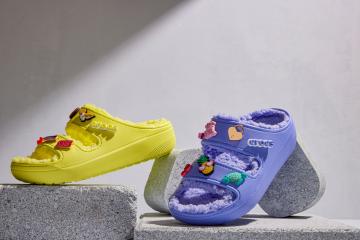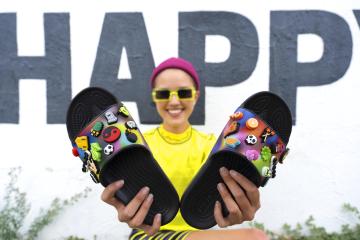
Crocs has been on a roll lately, and it very well might be because it has so thoroughly, efficiently and painstakingly embraced its exterior ugliness in its digital and social marketing. The plastic shoe brand, originally invented 20 years ago for use on and around boats, now is looking at more than doubling in size in the next five years.
How can such an odd-looking shoe have such mojo just as the nation appears to be coming out of COVID-19? NRF spoke with Crocs Senior Vice President and Chief Marketing Officer Heidi Cooley about the Crocs magic marketing formula.

SVP and chief marketing officer at Crocs
If Martians landed on earth and asked what Crocs are, how would you explain them?
I’d first say that Crocs are one of the most comfortable shoes in the world. I’d explain that they are molded footwear with holes to allow for comfort, breathability and self-expression. I’d say they can be personalized in ways that other shoes can’t, and they come in fun, vibrant colors and prints that can be attention-grabbing.
What’s the marketing zeitgeist in promoting such an ugly shoe as cool?
It’s grounded in this unique positioning of the brand that aligns with the very clear interest of our fans. We believe that Crocs are one of a kind and our fans define themselves as one of a kind.
They are the ultimate form of self-expression. It’s about being able to be who you are when you wear a pair of Crocs. We’re an icon that’s been working overtime for the past five years to be culturally relevant.
Has anyone ever tried to make Crocs look, well, attractive?
No. We are very confident being ugly. We love that the brand is polarizing. We have been ugly since 2002 and we have no intent to change that silhouette.
Crocs had a very unique marketing strategy during the pandemic. What was it?
Crocs entered the pandemic with strong brand momentum. We had record results going into it. But we were able to capitalize on the shift of wearing occasions. The pandemic allowed more consumers — many who would have never worn or considered — to try the brand.
Crocs reached out to health care workers way early in the pandemic. How and why?
That approach created one of the most impactful moments in the history of the brand by offering free pairs for health care workers. It’s about listening.
Health care workers needed the functional benefit of our shoes — which are easy to clean and incredibly comfortable. We temporarily paused all marketing activities and realized we needed to respond as a brand. Within five days, we instituted “Free Pair for Healthcare” and committed to ultimately giving away 910,000 pairs.

It validated that being a brand that listens makes us unique and different — and it gave us momentum. It taught us that doing good is always the right thing for Crocs.
Almost all of this was accomplished via social media. Crocs takes social media to extremes. Why?
We are a digitally led, social-first brand. That is at our core. We set out to ensure that we could make this brand relevant again. To have it come to life, it has to be where our fans are spending their time: digital and social.
We are a bold, innovative brand. It’s allowed us to do fun and disruptive innovations time and again. We are incredibly authentic to our DNA.
Yet Crocs delights in shaming Crocs haters via social media. Why?
When I joined Crocs, the top three Google search terms were all Crocs memes. People were looking to make fun of the brand. There are a lot of haters out there. We leaned in to that tension and we love that tension as a brand.
We find it a challenge to convert consumers and get Crocs haters to wear their first pair. The polarization of Crocs enables us to be incredibly creative.
Your most vital customers, Millennials and Gen Z, don’t like plastic very much. Why do they like Crocs?
Learn more about millennial and Gen Z consumers and how they shop retail.
They love the ethos of the brand. This generation is about self-expression, community and digital-first. That’s who we are. We rolled out a pretty clear commitment last year that our vision is that everyone should be comfortable in their shoes.
It’s also a commitment to comfort without carbon. We have fewer waste materials than most of our competitors because the mold has so little waste. So we already have one of the lowest carbon footprints in the industry. And we intend to reduce that by 50 percent by 2030.
How big can Crocs get?
Crocs envisions that it can become a $5 billion company by 2026 (vs. $2.3 billion in 2021). We plan an acceleration of the brand in Asia — a diversification of our silhouettes, and we plan to grow revenue in the sandals category.
What about retail store growth?
There are about 300 Crocs retail stores right now in the U.S. We’ll likely maintain that number. We don’t see our retail footprint growing aggressively.
Who are the biggest retail sellers of Crocs?
Everyone from Foot Locker to Dick’s to Famous Footwear to DSW.
Who is the most unlikely retailer selling Crocs?
Well, Foot Locker might seem pretty unlikely. But they drive incredible engagement. It shows our cultural relevance that an athletic footwear chain sells Crocs.

Has Crocs considered making anything besides Crocs shoes and its Jibbitz shoe charms?
The iconic clogs remain at the center of the brand. We always consider extensions. We now have a classic sandal. We believe there is a lot of opportunity to create sandal silhouettes. And you’ll see us extend into other categories like socks. ‘Crocs and sox’ is a trend. We will bring Crocs brand socks out later this year.
Can you talk about your celebrity ambassadors?
We had to show consumers how to wear Crocs. One catalyst was to work with a variety of brand ambassadors. We also work with influencers and content creators who show consumers how to wear such a polarizing shoe.
We only work with partners that have actually been wearing the brand, like Justin Bieber and Post Malone.
Some of your partners have been surprising: Why would anyone want to wear a pair of Crocs that smell like KFC fried chicken?
We like a lot of versatility and creativity with our partners. KFC was something a lot of fans wanted. It sold out within seconds.
What is your advice to retailers that want to have the mojo that Crocs has?
At the forefront of being consumer-centric is social listening. That is such an easy and affordable tool for all brands. That can create an incredible brand connection.
How do you ‘social listen’?
We hire really smart and creative team members right out of college to help us on social media. They are incredibly savvy on platforms and can create incredible conversations on behalf of the brand.
Is there a Crocs item that you, personally, are dying to sell but haven’t figured out how to do it yet?
I’d love to see a disruptive, 3D foldable Jibbitz. We once had a Croc with a tiny fanny pack on the back that was big enough to fit a credit card.


